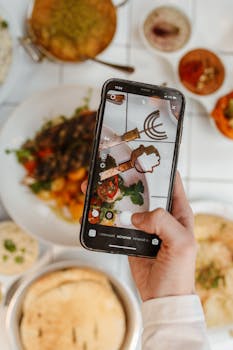Anuncios
Social media has transformed how we interact with food, reshaping dining experiences and influencing dietary choices. Platforms like Instagram and TikTok provide visual inspirations that extend beyond traditional cookbooks.
As images of beautifully plated dishes circulate online, they ignite cravings and inspire culinary creativity, altering our relationship with what we eat. Hashtags like #foodporn and #cleaneating have emerged, setting trends and defining food culture.
Moreover, social media acts as a powerful marketing tool for restaurants and food brands, offering insights into consumer preferences. This article will explore the various ways social media impacts our food experience from trends to community engagement.
The Rise of Food Influencers
Food influencers shape how we perceive meals and dining. Their visually appealing content garners attention, inviting followers to engage. Influencers curate unique food experiences, redefining culinary aspirations.
Culinary enthusiasts can connect directly through social media, fostering a sense of community. Sharing recipes and cooking tips becomes interactive, with influencers providing real-time feedback to their audience.
Anuncios
Additionally, these influencers often collaborate with brands, leading to sponsored content that drives visibility. The endorsement of a product by a trusted figure can significantly sway consumer choice.
As followers replicate influencer meals, trends proliferate, and certain dishes become viral sensations. This phenomenon encourages restaurants to adapt their menus according to what’s trending online.
Ultimately, food influencers not only popularize dishes but also create a culture around food enjoyment. Their impact solidifies their role as pivotal figures in modern food landscapes.
Anuncios
The Role of Visual Appeal
Images play a critical role in food marketing on social media. Visually striking photographs stimulate desire and engagement. High-quality images can elevate a simple dish to a gourmet status in the eyes of the viewer.
Simplistic yet captivating visuals are essential. Often, dishes topped with colorful ingredients or unique plating attract attention. This emphasis on aesthetics reshapes how we communicate about food.
Food photography has become an art form, teaching viewers effective styling techniques. Educational content allows anyone to elevate their culinary presentations and share visually tempting meals.
Moreover, platforms like Instagram thrive on visual content. The instant sharing of food pictures has created an ongoing dialogue about meal presentation and innovation in cuisine.
As social media norms evolve, the quest for visually appealing food continues. Restaurants now invest in design and plating, knowing this directly affects customer attraction and engagement.
Social Media and Culinary Trends
Trends flourish rapidly on social media, often dictating what diners crave or wish to avoid. Dishes like avocado toast and rainbow bagels demonstrate how social media can elevate certain foods into viral status.
Food trends also reflect broader dietary movements. The rise of plant-based diets and gluten-free options correlates with increased visibility on social media, showcasing these trends’ growth.
Challenges such as “#30daysofvegan” promote widespread participation, encouraging users to share their experiences actively. These movements generate excitement around particular diets, merging community with culinary exploration.
Social media facilitates global food trends, connecting diverse cultures through shared culinary experiences. Users eagerly embrace international flavors and recipes, expanding their horizons beyond local cuisine.
Tracking these trends helps restaurants and brands to adapt their offerings efficiently. Observing online conversations can lead to informed decisions about menu changes and marketing strategies.
The Power of User-Generated Content
User-generated content (UGC) creates organic marketing for brands. When customers post their food experiences, they generate authentic buzz that resonates more than traditional advertising.
Social media encourages customers to share meals, tagging restaurants and products. This process builds community trust, showcasing real experiences that influence potential visitors’ choices.
Restaurants can amplify this by featuring customer posts on their channels. This recognition fosters loyalty, encouraging patrons to return, feeling valued and appreciated.
UGC offers valuable insights into customer preferences. Analyzing posts reveals what diners enjoy or dislike, allowing brands to pivot and improve their offerings accordingly.
As social media shifts the marketing landscape, UGC will become increasingly vital. Its role as an authentic voice strengthens the connection between customers and brands.
Healthy Eating and Social Media
Social media encourages a focus on healthy eating. Hashtags like #healthyeating and #balanceddiet promote awareness around nutritious food choices and inspire accountability among users.
Wellness influencers share ideas on meal prep and clean eating, making healthy options more accessible. This accessibility empowers individuals to make informed dietary decisions.
Moreover, challenges and trends surrounding health often traverse social platforms. Users participate in movements such as “#Whole30,” sharing their progress and communal motivation.
Social media also creates awareness about food-related issues, including sustainability, food sourcing, and ethical eating. This information drives consumers toward mindful choices in the marketplace.
Ultimately, social media promotes not only attractive meals but also provides a space for meaningful conversations concerning health and nutrition. This engagement opens paths to healthier lifestyles.
Social Media’s Impact on Food Businesses
For food businesses, social media represents an invaluable marketing tool. It allows restaurants to showcase their offerings directly to potential customers, expanding their reach significantly.
Effective use of social media can drive foot traffic and online orders. Visual content, promotions, and customer engagement create a vibrant online presence, capturing consumer attention.
Businesses can use analytics tools to track the effectiveness of campaigns. Insights gleaned from performance data inform strategies, leading to targeted marketing efforts that resonate with the audience.
Social media also facilitates immediate feedback from customers. Reviews and comments provide insights that can help businesses improve service and food quality, fostering a culture of continuous improvement.
As competition increases, mastering social media marketing becomes crucial. Restaurants that effectively harness these platforms will likely thrive in this dynamic landscape.
Conclusión
Social media profoundly influences our relationship with food. It shapes trends, fosters communities, and creates opportunities for culinary exploration. The impact of these platforms underscores the evolving nature of dining.
Through visuals and shared experiences, social media connects people with food in innovative ways. Its ability to influence choices and behaviors emphasizes the importance of engagement in culinary endeavors.
As we continue to navigate the digital landscape, understanding these dynamics is crucial for food enthusiasts and businesses alike. The realm of food and social media will keep evolving, creating exciting possibilities.
In summary, the intersection of social media and food culture enhances our culinary experiences and shapes dining preferences. Embracing this change is essential for individual exploration and industry growth.
Looking ahead, remaining adaptable to these shifts will be vital. The community formed around food online will continue to thrive and innovate, offering endless opportunities for growth and connection.



